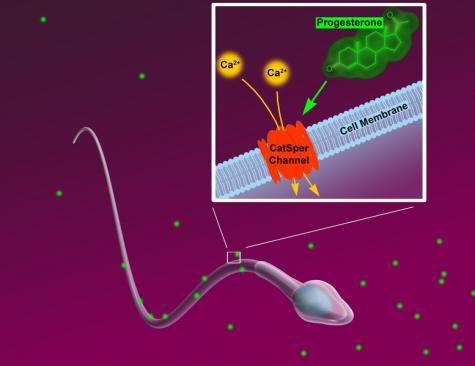March 17, 2011 weblog
Non-hormonal contraceptive a future possibility

(PhysOrg.com) -- Researchers from the University of California, San Francisco and the Center of Advanced European Study and Research in Bonn, Germany published simultaneous papers this week in Nature which could pave the way to creating a non-hormonal method of birth control.
The study focused on the male sperm and what stimulates it to find and penetrate the female egg. It has long been known that progesterone plays a part in the stimulation, however, until this study, the direct role it played was unclear.
Ion channels (molecular gates on the membranes of cells) on the mature sperm's tail, called CatSper, are unlike any other ion channels throughout the body. Research shows that this specific channel carries calcium to the tail of the sperm, causing it to become hyperactive. It is this hyperactivity that propels the sperm towards the egg and enables it to penetrate the surrounding cells.
These current studies were able to make the connection between the progesterone hormone and CatSper. Previous studies in mice show no connection between the two, but by studying the human sperm, this study showed that progesterone and its ability to activate sperm cells is specific to humans.
When the female body releases progesterone, the CatSpers immediately send a wave of calcium to the sperm’s tail. This creates the aggressive swing which propels it towards the egg and allows it to break through to deposit DNA and fertilize the egg.
This study also provided information towards infertility. If these CatSpers do not function correctly, the sperm will not be able to reach or fertilize the egg.
This new information provides an opening to the creation of a non-hormonal contraceptive. The current hormonal contraceptives work to prevent pregnancy by preventing the release of an egg from the ovaries and changing the cervical mucus to make it more difficult for the sperm to locate the egg.
The new study shows that these CatSper channels are unique to the sperm itself. By finding a way to block the CatSper channel from functioning, the sperm will no longer be able to locate and fertilize the egg.
While current hormonal contraceptives are effective, the hormones can create side effects such as an increased risk of blood clots, high blood pressure, and breast cancer. Because the CatSper channels are unique to sperm, the likelihood of side effects would be minimal and would make it the ideal form of contraception.
More information:
-- Progesterone activates the principal Ca2+ channel of human sperm, Nature 471, 387–391 (17 March 2011) doi:10.1038/nature09767
-- The CatSper channel mediates progesterone-induced Ca2+ influx in human sperm, Nature 471, 382–386 (17 March 2011) doi:10.1038/nature09769
(c) 2010 PhysOrg.com















